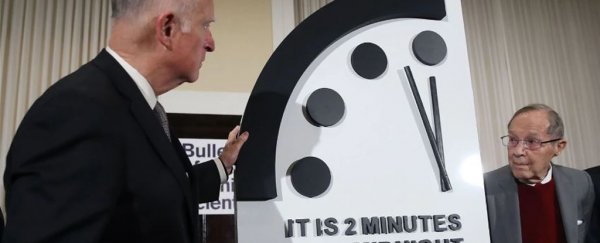The Bulletin of the Atomic Scientists is keeping the Doomsday Clock set at two minutes to midnight - a metaphor for the end of the world - calling the threats against humankind "a new abnormal".
The scientists announced Thursday that the clock is stuck at 11:58, citing nuclear weapons and climate change as two existential risks that leave the world dangerously close to an apocalypse.
"The 2019 time should not be taken as a sign of stability but as a stark warning," Bulletin President Rachel Bronson told reporters at the National Press Club in Washington.
"It's a state as worrisome as the most dangerous times of the Cold War. It's a state that features an unpredictable and shifting landscape of simmering disputes that multiply the chances for major conflict to erupt. This new abnormal is simply too volatile and too dangerous to accept as a continuing state of world affairs."
"Recognizing this grim reality," she continued, "it is still two minutes to midnight - remaining the closest to midnight that the clock has ever been set."
Bronson said the current time is the closest it has been to doom since 1953, when the United States and Soviet Union began testing hydrogen bombs.
Following the announcement, she told The Washington Post that the scientists decided that keeping the clock set at that "daunting time" was appropriate because "the time corresponded to the message we were sending."
She said the board was mainly concerned that "US-Russian relations are near an all-time low," "the arms-control architecture is deteriorating" and "carbon emissions are rising after a period of plateauing."
More specifically, the scientists referenced the unresolved issues with North Korea and President Trump's decision to abandon the nuclear deal with Iran.
"Meanwhile," the Bulletin's Science and Security Board said, "the world's nuclear nations proceeded with programs of 'nuclear modernization' that are all but indistinguishable from a worldwide arms race, and the military doctrines of Russia and the United States have increasingly eroded the long-held taboo against the use of nuclear weapons."
Bronson also emphasized "the intentional undermining of the information architecture for political purposes."
In fact, the scientists have referenced a "reckless use of language" in the past but, this year, they called it out and expressed deep concern, Bronson said.
"We began seeing very intentional efforts to undermine our ability to understand truth from fiction," she said, calling attempts to distort reality "a threat multiplier." "We worry that it will make dealing with these big issues all the more difficult."
Former California governor Jerry Brown (D) and former secretary of defense William Perry, who are both members of the Bulletin's board, wrote in an op-ed Thursday for CNN that the world has not been in this much danger since the Cold War.
"We have to go back 66 years, to 1953, to find a time of equal danger: The Soviet Union had just tested a hydrogen bomb. Eastern Europe was in the iron grip of the Soviet Union. There was danger of a military conflict erupting in Berlin. And US troops in West Germany, fully expecting an invasion, were preparing to use tactical nuclear weapons against the invaders," the op-ed read.
It added that "a new Cold War is underway - one equivalent to the most dangerous year of the first Cold War."
The clock, a metaphorical measure for humankind's proximity to destruction, has wavered between two and 17 minutes to the apocalypse since its inception in 1947.
The Bulletin of the Atomic Scientists was founded by veterans of the Manhattan Project who were concerned about the consequences of their nuclear research.
One of them, nuclear physicist Alexander Langsdorf, was married to artist Martyl Langsdorf, who created the clock and set it at seven minutes to midnight, or 11:53, for the cover of the group's magazine. Her husband moved the time four minutes ahead in 1949.
Since then, the Bulletin's board has determined how far the clock's minute hand will move, usually to draw attention to worldwide crises that it believes threaten the survival of the human species.
The group's reasoning has traditionally focused on the availability of nuclear weapons and a willingness among the world's great powers to use them.
However, in recent years, the scientists have also considered the threat posed by climate change, which the scientists warned in 2007 is "nearly as dire" as the dangers of nuclear weapons.
Last year, the clock advanced 30 seconds, to two minutes to "midnight." It had also advanced 30 seconds in 2017 but did not move at all in 2016.
The decision to move up the time on the clock last year was motivated largely by the Bulletin's sense of looming nuclear peril.
It listed a series of grim developments: North Korea had made rapid progress in developing a thermonuclear weapon capable of reaching the United States. Relations between the United States and Russia had deteriorated, with no high-level arms-control negotiations happening between the two countries. And nations around the world were moving to modernize and enhance their nuclear arsenals.
In addition, the organization cited unchecked artificial intelligence, the alarming spread of disinformation and the public's eroding trust in institutions.
Bronson, the Bulletin president, said Thursday that although the scientists noted an upsetting change in the information ecosystem in 2018, they did not see a "qualitative" change with other threats that would have warranted resetting the time on the clock.
So for now, the Doomsday Clock is stuck.
"In fact," Bronson told The Post, "we expect to be here for some time, in this precarious situation, which is why we're calling it the 'new abnormal.' "
That said, she added, "things can happen for good or for bad very quickly."
2018 © The Washington Post
This article was originally published by The Washington Post.
